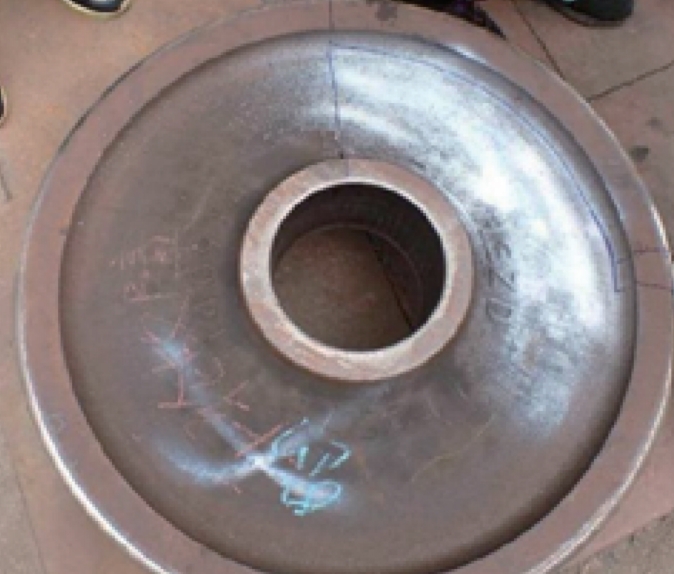Abstract
This article presents a comprehensive approach to welding repair and pressure leak stoppage for casting defects in high-strength steel wheels. The focus is on ensuring the absence of porosity and cracks in the base material at the repaired defect locations, thereby enhancing the overall repair effectiveness. After assessing the weldability of 40CrMnMo steel wheel material, preheating and post-heat treatment steps are introduced to prevent cold welding cracks during repair. Prior to pressure leak stoppage, the IPG nanosecond high-pulse laser is utilized to remove surface contaminants from the defect locations. The J107Cr electrode is employed for welding repair under pressure leak stoppage conditions. The tensile properties, impact absorption energy, and fracture stress of wheel specimens are analyzed under varying thermal inputs, interpass temperatures, and predicted temperatures. The results indicate optimal mechanical properties and the absence of porosity at the repaired defect locations when using a thermal input of 1.00 kJ/mm, an interpass temperature of 105°C, and a predicted temperature of 120°C.

Introduction
Wheels are the core components ensuring smooth and safe vehicle operation, with their structural stability directly impacting the overall safety of the vehicle. During operation, the wheel rim experiences radial load impacts from both the wheel itself and the road surface. When the vehicle turns or deviates from a straight path, axial stresses are applied to the wheel rim. The presence of casting defects during wheel manufacturing can significantly compromise wheel stability, ultimately affecting driving safety.
Therefore, rigorous inspection for casting defects during wheel manufacturing is crucial, and timely repair measures must be implemented to ensure driving safety. Previous studies have explored various methods for repairing defects in wheels, such as pre-forming molds and forging dies for wide-rim wheel folding defects [1] and analyzing the causes of weld cracking in C380CL steel wheels [2]. However, these methods often overlook effective surface cleaning prior to repair, which can lead to porosity at the repaired locations.
The pressure leak stoppage method, commonly used in repairing defects in pipeline materials, offers advantages in dynamic environments. Given the high production costs of high-strength steel wheels, an effective post-welding repair method for casting defects can significantly reduce manufacturing costs. This article applies the pressure leak stoppage method to welding repair of casting defects in high-strength steel wheels and analyzes its effectiveness through numerical simulations, providing a theoretical basis for practical applications.
Materials and Methods
1. Material Characterization
The high-strength steel wheel studied in this article primarily uses 40CrMnMo ultra-high-strength steel with a yield strength of 926 MPa. The chemical composition of this steel is shown in Table 1.
Table 1: Chemical Composition of 40CrMnMo Ultra-High-Strength Steel (Mass Fraction, %)
| Element | C | Mn | Si | Cr | Mo |
|---|---|---|---|---|---|
| Content | 0.41 | 1.10 | 0.26 | 1.10 | 0.26 |
The weldability of the high-strength steel wheel casting material is assessed by calculating its carbon equivalent using the formula:
w(C)eq=w(C)+61w(Mn)+51w(Mo)≈0.65%
Based on welding standards, the material exhibits poor weldability, necessitating reasonable preheating temperatures and post-heat treatment after welding repair.
2. Pressure Leak Stoppage Method Design
The pressure leak stoppage method involves locally tightening the casting defect area of the high-strength steel wheel under the compressive stress of the welding electrode. During the repair process, only the defective area is welded, with alternating cycles of tightening and welding until all defects are sealed. This segmented repair mode is particularly suitable for crack defects.
3. Electrode Selection
To prevent regional softening caused by thermal effects during pressure leak stoppage, a J107Cr electrode was selected for welding repair based on realistic standards. This electrode has a tensile strength of the deposited metal slightly lower than that of the 40CrMnMo ultra-high-strength steel used in the wheel casting. The chemical composition of the J107Cr electrode is presented in Table 2, showing its balanced content of carbon, manganese, silicon, chromium, molybdenum, vanadium, sulfur, and phosphorus. This balanced chemical composition ensures that the electrode can withstand the thermal stresses during the welding process without significantly softening the surrounding base material, thereby maintaining the overall integrity and strength of the repaired wheel.
The selection of J107Cr electrode was crucial for the success of the pressure leak stoppage method, as it provided a strong and reliable welding material capable of withstanding the rigorous conditions of the welding repair process. The lower tensile strength compared to the wheel material ensures that the weld is not overly brittle, allowing for better stress distribution and a reduced risk of crack propagation during operation.
Furthermore, the use of a compatible electrode ensures that the welding process is smooth and efficient, reducing the likelihood of welding defects such as porosity and cracking. This, in turn, leads to improved mechanical properties and higher overall repair quality.
In summary, the selection of the J107Cr electrode for welding repair in the pressure leak stoppage method is a well-considered decision based on the material properties, welding requirements, and overall objectives of the repair process. It ensures that the repaired wheel meets the necessary safety and performance standards, making it suitable for continued use in demanding applications.
